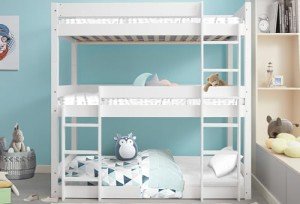Why You'll Need To Find Out More About Bunk Beds Sale
Bunk Beds Sale: A Comprehensive Guide to Choosing the Right Bunk Bed for Your Home
Bunk beds have long been a staple in children's bed rooms, providing a mix of space-saving efficiency and enjoyable. Whether accommodating brother or sisters, friends on slumber parties, or merely optimizing a playroom, bunk beds have ended up being an essential element in modern family homes. As sales on bunk beds rise, it becomes progressively important for customers to make educated choices when acquiring one. This post will cover the fundamentals of buying a bunk bed, from types to safety functions, in addition to pointers for maintaining the stability of your financial investment.
Types of Bunk Beds
When thinking about a bunk bed sale, it's crucial to understand the different styles readily available on the market. Below are the most typical types:
Traditional Bunk Beds: These include 2 beds stacked one above the other, sharing a single frame. They are frequently the most cost-effective option.
L-Shaped Bunk Beds: This design includes one bed positioned vertically and another horizontally. This plan develops extra space beneath the upper bed, which can be used for storage or a play area.
Lofted Beds: Similar to traditional bunk beds but with no lower bed. Rather, the space underneath can be made use of for a desk, play location, or extra storage.
Triple Bunk Beds: For households with a larger number of children or regular sleepovers, triple bunk beds supply three sleeping areas in a space-efficient design.
Futon Bunk Beds: These styles combine bunk beds and futon sofas. The bottom section converts into a separate seating area, boosting functionality.
Convertible Bunk Beds: These beds can be separated into 2 private beds, making them flexible as children's needs change over time.
Table 1: Comparison of Bunk Bed Types
Type
Description
Space Efficiency
Extra Features
Standard Bunk Bed
Two beds stacked vertically
High
Most basic style
L-Shaped Bunk Bed
One vertical and one horizontal bed
Moderate
Play or storage space
Lofted Bed
Elevated bed with open space below
High
Work/play location
Triple Bunk Bed
3 stacked beds
Extremely High
Accommodates more users
Futon Bunk Bed
Bunk bed with a convertible futon
High
Multi-functional
Convertible Bunk Bed
Can be divided into 2 separate beds
Moderate
Flexibility & & durability
Safety Features to Consider
Security is critical when purchasing a bunk bed. Below are key security features to try to find:
Guardrails: Adequate guardrails must be present on both sides of the upper bunk to prevent falls. They need to be at least 5 inches greater than the bed mattress.
Ladder Design: Look for durable, broad ladders with slip-resistant rungs. Make sure that the angle is not too steep for easy gain access to.
Stability: Ensure the bed is built with strong products, such as solid wood or heavy-duty metal. The bed must not wobble when in use.
Weight Limit: Check the weight capacity of the bunk bed to guarantee it can accommodate the designated users safely.
Product Safety: If possible, choose beds made from non-toxic products or those meeting security requirements for children's furniture.
Table 2: Essential Safety Features
Function
Description
Importance
Guardrails
Sides of upper bed to prevent falls
Important for child safety
Ladder Design
Strong, slip-resistant rungs
Aids safe and easy gain access to
Stability
Build quality to prevent wobbling
Makes sure safety and durability
Weight Limit
Maximum weight capability
Avoids accidents
Product Safety
Non-toxic, safe products
Secures kids's health
Upkeep Tips for Bunk Beds
To extend the life of your bunk bed and make sure continuous safety, consider the following upkeep tips:
Regular Inspections: Periodically inspect the structure for loose screws, bolts, or any indications of wear. Tighten fasteners as essential.
Clean Periodically: Dust and tidy the surfaces regularly. Usage appropriate cleaners that won't harm the surface.
Inspect Weight Limits: Be conscious of weight limits, especially with older children or adults who may want to use the upper bunk.
Avoid Climbing on Guardrails: Educate kids not to utilize guardrails for climbing up or playing to minimize the danger of accidents.
Frequently Asked Questions (FAQs)
Q1: What is the age limit for kids to securely utilize bunk beds?A: While it differs by the producer, lots of advise that kids under six ought to not oversleep the upper bunk due to safety issues.
Q2: How can moms and dads discourage risky climbing?A: Setting clear rules about bunk bed use and monitoring children can help. In Bunk Beds Children's loribloggs.top , using a bed camping tent can discourage climbing up while creating an enjoyable sleep environment.
Q3: What should I think about when decorating a space with bunk beds?A: Ensure there suffices space around the bunk bed for safe movement, and use the decor to create personalized spaces for each kid.
Q4: Is a lofted bed appropriate for older children?A: Yes, lofted beds can be appropriate for older children as long as they meet security requirements and the kid is accountable enough to use them securely.
Bunk beds serve a practical purpose while including an aspect of enjoyable to a kid's bedroom. As sales of bunk beds continue to rise, careful consideration of types, security features, and maintenance practices is essential for moms and dads and caretakers. By comprehending these important factors, families can discover the perfect bunk bed for their home, guaranteeing both usefulness and security for years to come. Whether it's for brother or sisters sharing a room or producing a comfortable slumber party space, a well-chosen bunk bed can provide happiness and practicality, making it a worthwhile investment.
